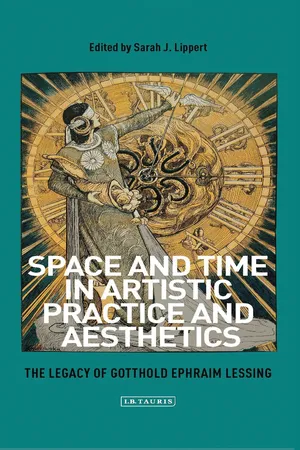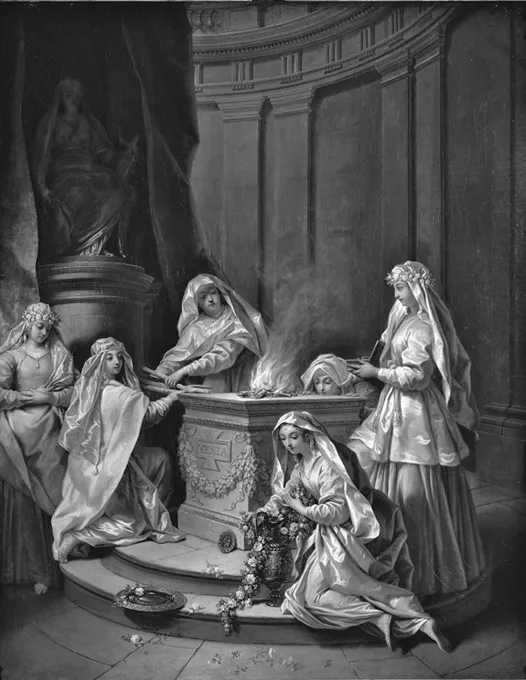![]()
In 1727 and 1728, French Rococo painter Jean Raoux (1677–1734) executed his best-known works, The Virgins of Ancient Times and The Virgins of Modern Times (1727 and 1728), respectively. Although executed at different moments, these two paintings share similar subject matter and dimensions, making them logical pendants.1 In this pairing, Raoux’s visual statement anticipated what German philosopher and critic Gotthold Ephraim Lessing (1729–81) would codify in writing nearly four decades later: a strict boundary between the oppositional realms of painting and poetry, ancient and modern, and male and female.
To modern eyes, Raoux’s paintings offer complementary images that illustrate honorable women, both past and contemporary, who engage in virtuous activity. For both Kathleen Nicholson and Guillaume Faroult, Raoux’s modern virgins are as morally upstanding as their antique counterparts.2 Nevertheless, a reading with a consideration of Lessing’s theories yields images that offer not a complementary pair of images, but paintings that work in opposition to each other.3 The contrast between these two paintings is not confined to subject alone. The formal qualities of each painting also reinforce a conflicted rather than a harmonious relationship between them. Raoux’s paintings of women, ancient and modern, anticipated the stringent boundaries that Lessing would reinstate between the genres of painting and poetry nearly 30 years later in his most important contribution to art-historical theory and criticism: Laocoön: An Essay upon the Limits of Painting and Poetry (1766).
Although Lessing published his thoughts on painting and poetry well after Raoux had died, there were several artists and academics during Raoux’s lifetime who set out to define the natural limits or qualities of the arts. As an active member of the Académie royale de peinture et de sculpture, Raoux would have been familiar with such works as Roger de Piles’s (1635–1709) Cours de peinture par principes (1708) and Dialogue sur le coloris (1673), Antoine Coypel’s (1661–1722) Sur l’esthétique du peintre (1721) and, perhaps most influentially, Abbé Dubos’s Reflexions sur la poesie et la peinture (1719).4 In Section XL of his Reflexions, Dubos speculated if painting’s power is greater than that of poetry. He concluded that painting has greater emotional impact than poetry, because it is assessed through vision or sight, being for him the sense that has the greatest empire over our souls.5 Like Lessing, Dubos privileged poetry as an art of the intellect and ideas, whilst painting was more closely aligned with nature, requiring no education to appreciate it.6 This essential division is reflected in Raoux’s paintings and in Lessing’s theories.
Raoux’s Paintings
In the Virgins of Ancient Times (Figure 1.1: 1727), the centre of the composition features an altar dedicated to Vesta, the Roman goddess of the hearth, home and family. This is clearly indicated from the text that appears on the altar: ‘Vesta’. In a setting that reproduces ancient and contemporary descriptions of the temple of Vesta in Rome, Raoux has placed six young women within a centrally planned temple, recalling a paragon of Roman architecture, the Pantheon, for French viewers.7 These young women work together tending to a burning flame. According to Ovid, fire was looked upon as sacred, sterile and pure; it was for this reason that virgins were chosen to maintain Rome’s sacred flame.8
These young women are united in a common purpose, each tending to a different aspect of the ritual maintenance of the sacred fire. They range in age from adolescence to adulthood and all of these virgins wear long, loose-fitting garments, whilst some of their veils are held in place by floral wreaths. They are circumscribed by a simple Doric interior, with no open windows, doors or garden view. Partially hidden by drapery, a statue of the goddess Vesta favours these maidens; she is seated and holds in her hand the palladium, which is a statuette of Minerva, the goddess of wisdom. In a vestal context, this mini-Minerva refers to the statuette taken by Aeneas from Troy to the future site of Rome. For ancient Romans, the well-being of the palladium ensured the safety and well being of the Roman state.9 The vestals, whose tour of duty within the cult lasted 30 years, were in charge of the palladium, and of keeping the flame of Rome burning forever. If the flame was ever extinguished, it was considered a sign that one of the vestals had broken her vow of chastity, thereby placing Rome in a state of jeopardy. Therefore, virginity and female chastity were signifiers of the state’s political stability. This was as true in antiquity as it was during the eighteenth century. Several eighteenth-century accounts of Roman vestals, who had transgressed sexually, reported that they were stoned to death or buried alive outside of the walls of the city as punishment.10
In contrast to their classical counterparts, the Virgins of Modern Times (Figure 1.2: 1728) are cast in a luxuriously decorated, eighteenth-century interior with a gilt wood table, expensive decorative objects, and baskets of fruits and flowers; it looks as if these modern virgins are preparing for a party. Through an arch at the centre of the composition extends a vast hallway with a barrel-vaulted ceiling, flanked by a marble colonnade with gilded ionic capitals. The ceiling fresco in this hallway depicts Apollo holding his lyre as the god of culture and, in particular, of music and poetry. He serves as a foil to Vesta, who is the patroness of everything domestic.
Unlike their ancient ‘sisters’, these modern virgins are engaged in a number of seemingly unrelated activities. This lack of unity is emphasised by the way in which the women move or look out of the picture plane and by the self-absorption of the girl who reads in the left foreground. Gone is the hearth of open flame in the Virgins of Ancient Times, leaving a conspicuous void at the centre of the composition. This void intensifies the liberating expansion of depth in the painting and contrasts with the circumscribed space occupied by the ancient virgins.
The reading girl in the left foreground anchors the composition. Her book is of medium format and is almost certainly not a religious text or a novel. Those types of books were, more often than not, small in format. Most likely, she is reading a secular text, or perhaps a history or scientific book.11 Behind the reading girl, a female servant carries a tray to a place that is located outside of the picture plane, while farther back in the composition, a woman adjusts her veil in front of a full-length mirror.
At the right side of the composition, four women are gathered around a fruit-laden table. Each one performs a different activity, not all of which are identifiable. In fact, the only women in this picture who are actually performing useful tasks, and are also wearing costumes most similar to those of the ancient vestals, are the female servants.
As such, Raoux’s pendants pit ancient integrity against contemporary decadence, and this contrast would not have been lost on eighteenth-century viewers, particularly in academic circles, where the rivalry between the ancients and the moderns had been raging since the seventeenth century.12
Lessing’s Theories
Although his theories were anticipated, as has been discussed, Lessing’s Laocoön was, in part, inspired by the theories proposed by one of the progenitors and champions of Neoclassicism, the German art historian Johann Joachim Winckelmann (1717–68). Lessing was intent on delineating the genres of poetry and painting. His essay was a response to or continuation of Winckelmann’s essays on the imitation and history of Greek art. In Laocoön, Lessing insisted that ‘Beautiful statues fashioned from beautiful men reacted upon their creators, and the state was indebted for its beautiful men to beautiful statues. With us [moderns], the susceptible imagination of the mother seems to express itself only in monsters’.13 Lessing’s statement on the superiority of ancient artists over those of his own time was a reaction to the perceived decadence, both artistically and socially, into which eighteenth-century culture had fallen. For Lessing, this cultural decadence signaled a transgression of all sorts of well-established boundaries. And, as one scholar has rightly noted, at the heart of Lessing’s philosophical meanderings is the most fundamental ideological basis for his laws of genre, specifically, the laws of gender.14 Although Lessing did not elucidate this explicitly in Laocoön, the above statement reveals Lessing’s gendered ‘contrast between the patrilineal production of ancient sculpture and the monstrous, adulterous maternity of modern art’.15
Further, Lessing associated antiquity with men and modernity with women. He also created a gendered binary between poetry and painting, insisting that ‘nothing obliges the poet to concentrate his picture into a single moment … every change, which would require from the painter a separate picture, costs him but a single touch’.16 By contrast, Lessing posited that ‘Objects which exist side by side … are called bodies. Consequently bodies, with their visible properties are the peculiar subjects of painting. Objects which succeed each other, or whose parts succeed each other in time, are actions. Consequently, actions are the peculiar subjects of poetry’.17 According to Lessing then, painting is only capable of presenting bodies in space, whilst poetry can offer actions in time. These are the axioms upon which Lessing formulated the boundary between poetry and painting. For Lessing, ...


